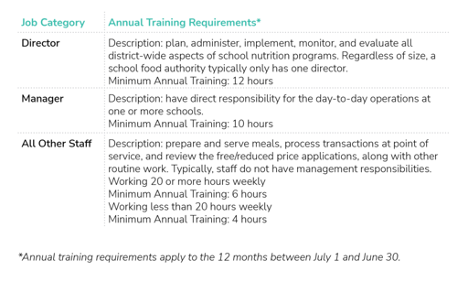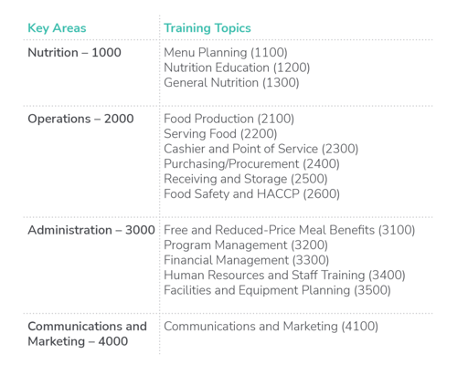Matthew Good, MS, RD, LD
As the school year is on the downswing and day-to-day operations are winding down, summer break lends a few moments to address the year-to-year responsibilities of a school nutrition program, such as professional standards. It is ultimately the program director’s responsibility to ensure they and the staff maintain and expand their knowledge base of school nutrition via adequate training, which can be challenging throughout the hectic school year. Additionally, summer can pose the additional obligation of hiring for staff turnover, making brushing up on hiring standards critical.
Did You Know?
i3’s Orange Apron Program offers complimentary onsite training, including vendor presentations and refreshments! Click here to find out more Orange Apron Club – Home | PaySchools
Hiring Standards
Understanding hiring standards is most likely the administration’s duty, as they only apply to the school nutrition program director position, and it would be unlikely for an exiting director to be hiring their replacement. When filling an open director position, the hiring person must understand their local educational agency (LEA) enrollment category to define the education and experience required. The USDA’s Professional Standards: Guide to Professional Standards for School Nutrition Programs provides clear guidance on these categorical hiring standards. It’s worth noting that at the time this article is being written, changes have been proposed, with public comment currently being taken on the hiring standards of medium and large LEAs.
Annual Training
Continuing education is the cornerstone of job performance for countless professions. Specific to school nutrition professionals, attention must be paid to the training hours by position category, topic areas, and record-keeping.
A wealth of online knowledge is dedicated to strategizing and rolling out an engaging and successful fundraiser, especially when simply accepting monetary donations. For example, GoFundMe has a section on its site dedicated to this.
Job Category and Minimum Training Hours
While annual training is required for all employed in a school nutrition program, varying minimum training hours apply based on the associated job category.
Further guidance is provided for mid-year hires, being any position filled before January 1 of a given school year must complete the associated number of hours for that role. If filled after January 1, half of the minimum training hours for that role must be completed. In circumstances involving temporary and acting employees, substitutes, and volunteers, minimum training falls under the guidance of the state agency.
Additionally, training may be obtained through various methods, such as in-person or online classes, local meetings, webinars, or conferences. While measured in hours, shorter duration training can be tracked. Best practice might point to 15-minute increments (0.25 hours).
Topic Areas
While the USDA does not approve nor require specific training programs, best practices advocate for assessing the training needs of the particular employee. They must be job-specific and intended to enhance job duty fulfillment. The four key areas are Nutrition (1000), Operations (2000), Administration (3000), and Communication and Marketing (4000). Each key area is broken into training topics; for example, under Nutrition (1000), you would find Menu Planning (1100), Nutrition Education (1200), and General Nutrition (1300). Consideration should be paid to the particular audience when planning training, as some topics may apply to an entire staff, and others to those with more specific job duties. The USDA offers a guide to learning objective descriptions to best plan for training.
Record Keeping
Many states have tracking tools for record-keeping purposes, and the USDA also offers an option. While these are not mandatory tools, logic suggests a system that tracks the employee’s name, position, employer/school, training title/topic, training source, date completed, and total training hours completed. No regulation exists on who maintains this record (the individual staff person, manager, director, etc.). Still, the states will audit these records as part of the Administrative Review process, so having immediate onsite access to these records is common sense. Individual state regulation may also offer flexibility on the carryover of excess hours from one year to the next; however, it is mandated federally that some training hours must be completed each year.
i3's Orange Apron
There are numerous resources available online and in your locale, but the process of professional development training and record-keeping can be daunting. i3 Education’s Orange Apron Program was specifically developed to help program directors make it fun while being consistent with professional development standards.
How It Works
You provide the location, such as a school in your district. We’ll work with you to invite local program directors to attend the event and send a team to provide training on a relevant topic of your choice (or you can choose from our library of previously developed content). These events, approximately 90 minutes in length, don’t just help to satisfy professional development requirements; they provide area directors a chance to network, resource-share, mingle, and have fun with other school nutrition professionals. i3 even provides catering and giveaways! Best yet, you do not have to be an i3 Education customer to host or attend an event.
Interested, or want more information? Fill out this form to have a representative contact you about hosting an event.
Matthew is a registered dietitian nutritionist and freelance content provider for i3 Education, with over a decade of experience in K-12 nutrition.


